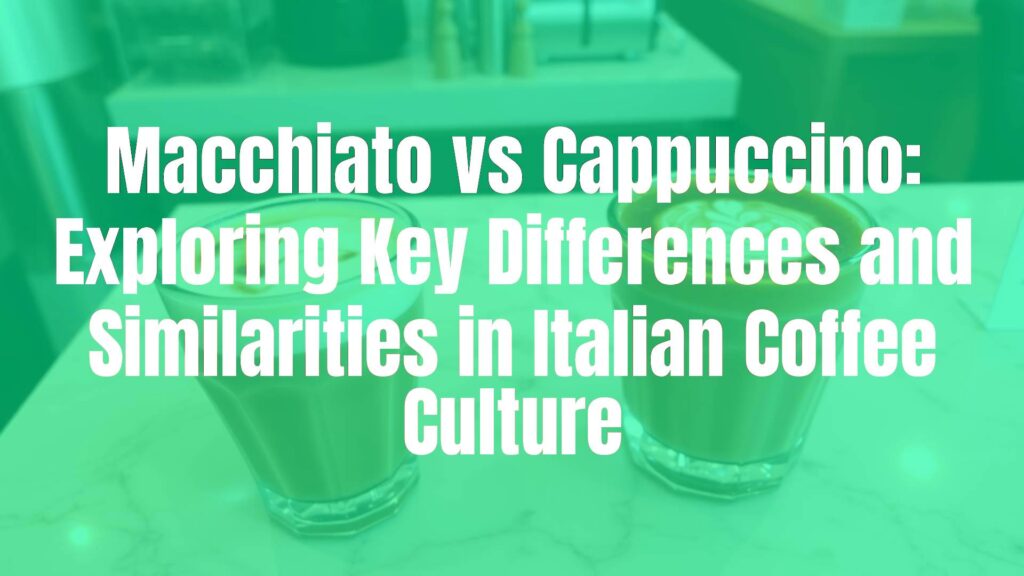Macchiato vs Cappuccino: An In-Depth Comparison
Introduction to Two Italian Coffee Classics
Italian coffee culture is renowned for its elegant simplicity and deep-rooted traditions. Among the rich array of coffee drinks are the macchiato and the cappuccino, two popular espresso-based beverages that are often compared, yet each possesses a distinct identity. Let’s dive into what sets the macchiato and cappuccino apart, and what brings them together, in the world of Italian coffee.
Definitions and Origins
The macchiato—from the Italian word meaning “stained” or “spotted”—is an espresso “stained” with a small amount of milk or milk foam. This drink is believed to have originated as a way for baristas to signal which espresso had a bit of milk added.
The cappuccino, by contrast, takes its name from the Capuchin friars, referencing the color of their robes due to the dark espresso mingled with frothy milk. Cappuccino has been a staple of Italian mornings since at least the early 20th century.
Preparation and Key Ingredients
Both drinks are built on a base of rich, freshly-brewed espresso, but they diverge significantly in their use and proportion of milk:
- Macchiato: Prepared by adding just a “mark” (typically a teaspoon or two) of foamed milk or steamed milk to a shot of espresso, resulting in a bold espresso flavor with a delicate hint of creaminess.
- Cappuccino: Prepared by combining equal parts espresso, steamed milk, and airy milk foam, usually in a larger cup. This creates a harmonious balance between coffee and creamy texture.
Flavor, Texture, and Appearance
The difference in proportions leads to distinct experiences:
- Macchiato: Characterized by a robust espresso taste, only slightly mellowed by the small amount of milk. The texture remains mostly similar to straight espresso, with a hint of smoothness and a thin layer of foam or milk on top. Visual appearance is typically a dark espresso with a light “spot” of white from the milk.
- Cappuccino: Known for its creamy, velvety mouthfeel thanks to a thick layer of microfoam. The taste is a seamless blend of coffee and milk, creating a milder flavor and softer feel. Visually, cappuccino has a uniform, frothy cap, often served with a dusting of cocoa powder, in a larger cup compared to the macchiato.
Serving Styles and Traditions
The macchiato is typically served in a small espresso cup (demitasse), meant for quick consumption. Due to its strength and concentration, it’s often enjoyed as a midday pick-me-up rather than a breakfast beverage.
The cappuccino is commonly served in a larger cup (usually around 150–180ml/5–6oz), making it Italy’s quintessential breakfast coffee, frequently paired with a pastry and generally not consumed after late morning.
Similarities Between Macchiato and Cappuccino
- Both are espresso-based drinks using high-quality coffee beans.
- Each incorporates milk in some form, though in very different proportions.
- Both drinks showcase the Italian emphasis on quick, skillful coffee preparation and consumption.
Common Misconceptions and FAQs
- Is a macchiato just a small cappuccino?
No; the macchiato uses much less milk, emphasizing espresso, while cappuccino is an even balance of coffee, milk, and foam. - Can I order a “latte macchiato” and get the same drink?
Not quite; a latte macchiato reverses the roles, with more milk “stained” by a shot of espresso. The classic macchiato is an espresso first, marked by milk. - Are cappuccinos only for breakfast?
In Italy, yes—cappuccino after noon is considered unusual, but international coffee culture is much more flexible. - Why do the appearances vary in cafés?
Variations in presentation, cup size, and milk texture can be influenced by region and barista technique, especially outside Italy.
Conclusion
While the macchiato and cappuccino are connected by their shared heritage and espresso foundation, their characteristics diverge sharply: the macchiato provides a pure, bold espresso with a subtle creamy accent, while the cappuccino delights with its harmonious blend of coffee and pillowy milk foam. Understanding both drinks deepens appreciation for the artistry of Italian coffee preparation and the nuanced preferences of its passionate enthusiasts.

